Eurovac.nu
You will find on the followingpages all the necessary informa-tion for a correct use of theworking unit. Therefore we sug-gest that the user carefully readsand follows the technical instruc-tions. Moreover we advise tokeep the user guide in a safe andhandy place. The above mentio-ned guide can be subjected tomodifications and further impro-vements.
GENERAL DESCRIPTION
LIST OF COMPONENTS AND SPECIFICATIONS
RULES FOR USE AND MAINTENANCE
OPTIONALS AND ACCESSORIES

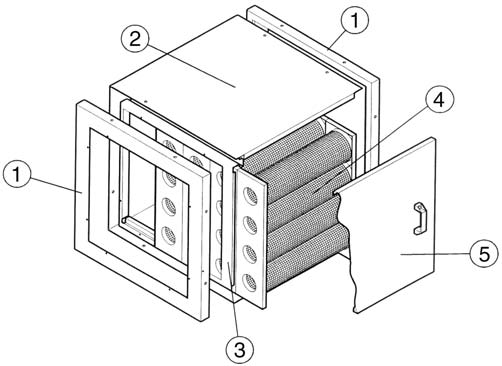
The filtering units Mod. CLEAN-CARBO, consisting of modular containers made of galva-nised sheet steel, are to be mounted in series: the polluted air goes in through theCLEAN side and comes out of the CARBO side. The CLEAN filter is made up of the com-ponents that can be seen in the exploded view of Fig. 1, whereas the components of theCARBO filter can be seen in the exploded view of Fig. 2.
1) Structure base
4) PRECLEAN prefilter
1) Structure base
4) Activated-carbon pack
2) Outer structure
5) SMOCLEAN filter
2) Outer structure
5) Inspection door
6) Inspection door
3) Activated-carbon pack guide
CLEAN
The first filter that has a pre-filtering action is a filter that is pleated (Item 4 of Fig. 1),
which thus provides a larger filtering surface within limited dimensions.
This filter consists of a galvanised sheet steel frame and galvanised and electrically wel-
ded protection meshes. Inside this structure is housed a filtering diaphragm made of
polyester fibres dressed with synthetic resins (see characteristics in Section 3).
The second filter making up CLEAN is a bag filter (Item 5 of Fig. 1) of the high efficiency
type with a large filtering surface. This filter consists of a diaphragm made of glass fibres
and glass microfibres.
This type of filter allows a low flow velocity of the air through the filter, thus ensuring mini-mal head loss, high filtering efficiency, and longer filter life. The frame supporting the filters is built in such a way as to make it easy to handle andreplace them. The filters are tested in compliance with ASHRAE 52-76 Standards. The mean efficiency and the characteristics of the filters are presented in the diagramsthat follow.
CARBO
This filter consists of a modular and sectional container made of galvanised sheet steel.
Inside the container there are four frames, which can be easily disassembled, where
cylinders can be mounted made of plastic micromesh and containing activated carbon.
Consequently, the air passes through the activated carbon inside the cylinders before
being forced outside.
Main data
Peso lordo: 25 Kg
Peso lordo: 42 Kg
Peso lordo: 48 Kg
Peso lordo: 88 Kg
A peculiar characteristic of the filters of the CLEAN-CARBO series is their modular structu-re, which makes it possible, via the combination of only two basic elements, to create awide range of filters, so as to meet the most varied requirements as regards filteringcapacity, as it is clearly illustrated in the diagram below.
(°) Position of inspection doors in the standard configuration

Gross weight: 48 Kg
Gross weight: 88 Kg
List of components
Specifications of materials
•Preclean filtering panels
Corrugated filtering panels, thickness 100 mm, consisting of a galvanised sheet steel
frame and polyester filtering medium with protective mesh.
The filtering diaphragm that is generally used is the A250 type, but more efficientdiaphragms or metal ones can be used. The PRECLEAN filtering medium is made of polyester fibres dressed with syntheticresins. The main characteristic of the filtering diaphragm is the fact that it is self-extin-guishing, which makes it particularly suitable for filtration in environments where thereis danger of flames or sparks.
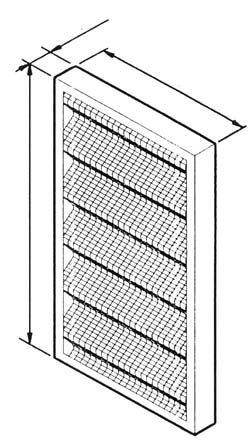
Technical characteristics of "Preclean" filtering medium
Max. degree of separation
87.5% (ASHRAE 52-76 atm Stds)
Recommended flow rate
Recommended air velocity
Initial head loss
Max. operating temperature
Self-extinguishing (F1 Class)
Eurovent 4/5 EU 3
Table of air flow rates (m3/s)
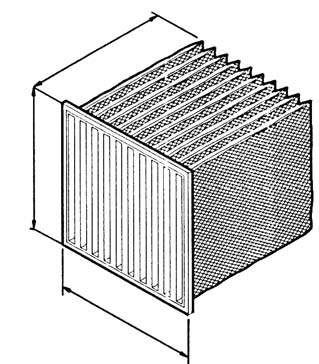
•Smoclean bag filters
These bag filters are made of filtering diaphragms made of glass fibre or glass microfibre
and having different grains and lengths according to the degree of efficiency required.
CLEAN mounts bags with 95% efficiency according to ASHRAE 52-76 Standards.
Technical characteristics of "Smoclean" bag filter
Efficiency, ASHRAE 52-76 Stds.
Initial head loss
Max. operating temperature
Non-flammable Class 2 (UL)
•Indicative diagram of Smoclean efficiency
It is not possible to give efficiency curve that is valid in absolute terms, since efficiency is
influenced by too many factors, such as dust load, air velocity through the filter, etc.
Dimensions of particles in micron (10-6 mm)

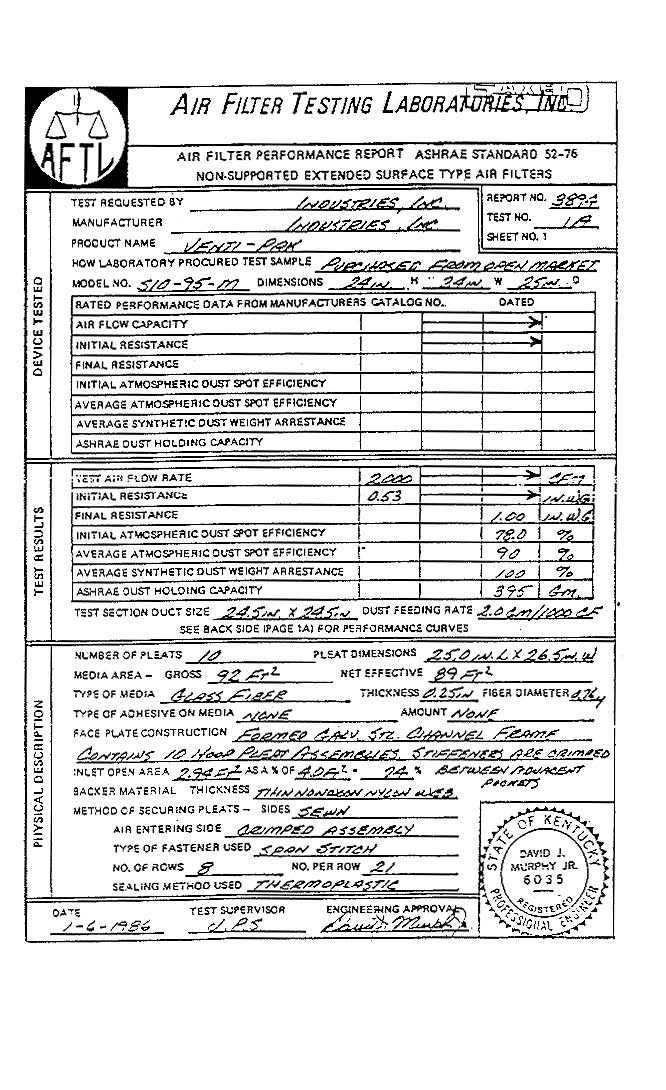
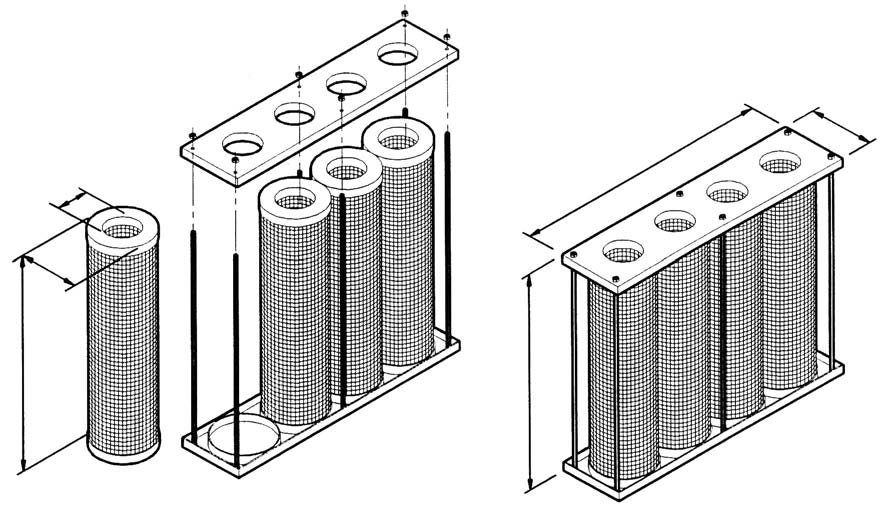
The activated carbon is contained in micromesh plastic cylinders in packs of 4. Thebasic module, CARBO 22, contains 4 packs of 4 cartridges each (sixteen 2.5 kg car-tridges for a total of 40 kg of activated carbon per module).
Technical characteristics of Activated carbon
Apparent density
Specific surface
1250 m2/g (±50)
Humidity content
Rules for use
and maintenance
•Applications
Filtration of welding fumes and of emissions containing gas that can be adsorbed by
activated carbon; filtering of air for pressurised clean rooms; filtration for reintegration
ducts (only CLEAN unit).
In any case, the CARBO unit must always be preceded by the CLEAN unit even if the air
is not full of dust, so as to optimise the service life of the activated-carbon unit.
The filter allows recycling of the air back into the working environment when it is applied
to welding fumes. It is, however, advisable to refer to local regulations set by the relevant
authorities in this regard, especially when high air flows are involved. The CLEAN-CARBO unit can be applied as a post-filter on painting booths (solventpaints). In this case, recycling of the air back into the working environment is not allowed(universally accepted technical rule). In the case of water booths, a regulated gate valve must be interposed between thebooth fan and the filter, to prevent air loaded with drops of water drops in suspensionfrom entering the filter. This would lead to early clogging of the bags and thus shorten theworking life of the activated carbon.
•Sizing criteria
The flow rate values indicated in the table are to be considered as maximum values that
cannot be exceeded. Hence, consider lower working flow rates, especially if the
CARBO unit is to be used. As regards how to size CARBO, the following theoretical
aspects must be borne in mind:
- Activated-carbon filters are suitable for intercepting all organic compounds and a large
number of inorganic compounds.
- Activated carbon may have a vegetal origin (coconut) or a synthetic origin (petroleum) - Activated carbon has a granular shape, with grain diameters ranging from 1 to 5 mm
and grain lengths ranging from 3 to 6 mm.
•Choice of activated-carbon cell
When choosing a filter, first of all it is necessary to check whether and to what extent the
activated carbon is able to adsorb the polluting substance.
If it is able, it is necessary to determine the amount of activated carbon required, accor-
ding to the concentration of the pollutant, the air flow rate, and the concentration of pollu-
tant allowed on expulsion.
Next, it is necessary to consider the number of hours of operation per day, the continuity
or discontinuity of operation, and the temperature and relative humidity of the air.
The activation technique bestows a high degree of porosity on the activated carbon. This
makes it possible to increase the inner surface (up to 1300 m2/g of activated carbon),
and hence its retention power.
No precise rules exist on the behaviour and retention capacity of the activated carbon,
but as a general rule it may be stated that:
- The greater the weight and molecular dimensions of a homogeneous lot, the higher the
- Gases and vapours having high molecular weights and boiling points are generally
In order to make it possible to establish the retention values, in the tables annexed a list isgiven of some of the more well-known substances along with the corresponding degrees
of adsorption. As may be noted, for most solvents commonly contained in paints, the adsorption capa-city is approximately 20% of the weight of the activated carbon (which means that each40-kg cell is able to entrap approximately 8 kg of solvent). Adsorption is a physical phenomenon whereby a solid substance (ADSORBENT) fixesanother substance (ADSORBATE) on its surface. The method of choice must take into account the effective adsorption capacity of the acti-vated carbon for the various substances. The table gives a list of various substances with the indications on the adsorption capa-city of the activated carbon.
For each of these substances is indicated in what percentage 1 kg of activated carbon issaturated.
Isopropyl alcohol
Deteriorated paper
Cellulose acetate
Isopropyl acetate
Acetic anhydride
Sulphur dioxide*
Food flavourings
Chloronitropropane
Nitrogen dioxide
Hydrogen chloride*
Carbon disulphide
Methylene chloride
Hydrogen bromide
Methyl ethyl ketone
Ethylene chloride
Corrosive gases*
Odours from putrefaction 1
Dichloropropane 1
Ethylene dichloride
N,N-dimethylaniline 1
Dimethyl sulphate
Perchloroethylene 1Pesticides 1
Lubricants and oils
Propyl mercaptan
Methylcellulose 1
Propionaldehyde 2
Methyl cyclohexane
Methyl cyclohexanone
Methyl cyclohexanol
Hydrogen sulphide
Methyl ethyl ketone
sym-tetrachloroethane 1
Tetrachloroethylene 1
Styrene monomer 1
Trichloroethane 1
Trichloroethylene 1
Sulphur trioxide*
Mercury vapours* 2
Hydrogen fluoride*
The adsorption of the activated carbon for the substances indicated is expressed viaindex numbers having the following meaning:
1 - High adsorption capacity: 1 kg of activated carbon adsorbs on average 20%
of its own weight.
2 - Good adsorption capacity: 1 kg of activated carbon adsorbs 10% of its own
3 - Poor adsorption capacity: the use of activated carbon can prove sufficient only
in particular conditions.
4 - Negligible adsorption capacity: the activated carbon cannot be used with sub
stances of this class.
* Indicates that the activated carbon must be impregnated with other substances; hence,the activated carbon supplied standard in our assemblies is not suitable.
MAINTENANCE
Maintenance intervals: these cannot be estimated beforehand in that they depend on:
- System capacity
- Concentration and type of pollutant
- Daily use of system
Maintenance should be carried out when the following occur:
- Considerable decrease in system capacity
- Warnings coming from special pressure switches mounted on the filter, which are appro-
priately set and are equipped with optical and acoustic alarms (see "Optionals").
•Clean
The PRECLEAN and SMOCLEAN filters can be taken out once the side inspection door is
removed (see position on general table) by loosening the fastening knobs.
The filters should first be shaken manually and then blown clean with compressed air. The
PRECLEAN filter is also washable; instead, the SMOCLEAN filter cannot be regenerated.
The filters are to be replaced when the cleaning operation is not able to restore the origi-
nal level of permeability and efficiency.
•Carbo
The saturation level of the activated carbon cannot be detected by instruments like pressu-
re switches, but only by sophisticated and costly analysers mounted on the outlet, which
are able to trace certain given substances.
In practice, for systems of small or modest dimensions, proceed as follows: - Assess the duration of the activated carbon on the basis of a theoretical calculation
(refer to the tables, values of concentration at intake, if these are available, and dura-tion of daily operation of the system).
In this way, it is possible to plan replacements. - Apart from the fact that the need for replacement of the activated carbon can obviously
be estimated from a higher level of smell in the emissions, another method consists inweighing the acticated-carbon cartridges, considering them to be exhausted when theincrease in weight is around the percentages previously indicated.
Indicative frequency of inspections for application on welding fumes:
once a month; replacement every six months
weigh the cartridges once a month
•Disposal of filters
The filter, including the activated carbon, must be disposed of as special refuse by spe-
cialised firms.
•Toxic and harmful substances
To change the filters, the filtering diaphragms must be taken out. Consequently, it is
necessary to handle filters containing a lot of dust. Handle them with care and put them
immediately into sealed containers.
•Differential pressure detector
To keep the head loss of the CORAL CLEAN filter under control, the fil-
ter can be equipped with:
1) Differential pressure gauge
2) Differential pressure switch
1) Differential pressure gauge
The pressure gauge is connected upstream and downstream of the fil-
ter. This makes it possible to identify the conditions of clogging (Fig. 1).
2) Differential pressure switch
Either of two versions can be supplied: 1) Simplified version with a switching function when a set pressure-drop value is reached 2) Version that offers the possibility of activating optical and acoustic alarms and remote switches,
which interfaces with control units.
The work range of the pressure switch is between 0 and 150 mm of H2O (Fig. 2).
•Technical data
Pressure range:
Supply voltage and frequency:
220/240 Vac - 50 Hz
Source: http://www.eurovac.nu/attachments/article/213/filterguide_cleancarbo.pdf
In Pharmacy, IMS MAT Jan 2011 To Fever and Pain INCLUDES DR. KEELY S TIPS Effective relief you can trust A Parent's Guide to Fever and Pain The content of this guide has been drafted in conjunction with Dr. JimKeely, who has spent 6 years working in Paediatrics at three of the mainteaching hospitals in Ireland. Dr Keely entered general practice in 1994and currently works as a GP at the Seabury Medical Centre in Malahidewith a special interest in Paediatrics. He is also the father of five childrenand gives us his personal top tips on how to deal with pain and fever.
Rivastigmine for the treatment of dementia associated with Parkinson's disease Jennifer L Reingold Abstract: Parkinson's disease (PD) affl icts millions of people worldwide and leads to cognitive impairment or dementia in the majority of patients over time. Parkinson's disease dementia (PDD) is characterized by defi cits in attention, executive and visuospatial function, and memory.









